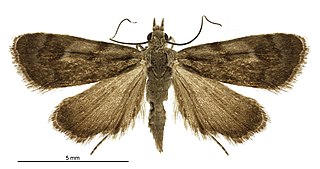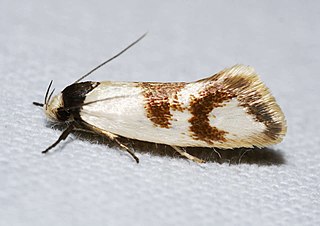Poecilasthena cisseres is a moth of the family Geometridae first described by Alfred Jefferis Turner in 1933. It is found in Australia, including Victoria.
Xyroptila peltastes is a moth of the family Pterophoridae. It is found in Australia.

Deuterocopus atrapex is a moth of the family Pterophoridae described by Thomas Bainbrigge Fletcher in 1909. It has been recorded from Sri Lanka, Assam, Selangor, the Tenasserim Hills, south-eastern Borneo, Ternate, Ambon Island, Batian, southern Sulawesi, the Sangihe Islands, Halmahera, Neu Pommern, northern New Guinea, the Kei Islands, the D'Entrecasteaux Islands and Queensland.

Sphenarches zanclistes is a moth of the family Pterophoridae that is found in Australia.
Eublemma lozostropha is a species of moth of the family Erebidae first described by Alfred Jefferis Turner in 1902. It is found from Kalbarri in Western Australia north around northern Australia, through central Australia and down the eastern coast to southern New South Wales.
Euprophantis autoglypta is a moth of the family Gracillariidae. It is known from India and Indonesia (Java).
Acrocercops lophonota is a moth of the family Gracillariidae. It is known from Java, Indonesia.

Phycomorpha metachrysa, the milktree fruit moth, is a species of moth in the Copromorphidae family. It is endemic to New Zealand and has been found in the North and South Islands. The larvae feed on the fruit of species in the genus Streblus including Streblus heterophyllus. This adults of this species is on the wing from October to April.

Agdistopis halieutica is a moth in the Macropiratidae family. It is found from Australia and New Guinea to Fiji.

Glaucocharis stella is a species of moth in the family Crambidae. It is endemic to New Zealand.
Conoeca psammogona is a species of bagworm that is known from Imerina in central Madagascar.
Tanycnema is a monotypic moth genus of the family Tineodidae or false plume moths. It was described by Alfred Jefferis Turner in 1922. Turner described the genus in Proceedings of the Royal Society of Victoria, writing:
Gen. Tanycnema, nov.
Frons with a strong anterior tuft of hairs. Tongue present. Palpi rather long, porrect. Maxillary palpi obsolete. Antennae short. Legs long, slender; outer tibial spurs about 3/4 length of inner spurs. Forewings narrow, elongate; 2 from well before angle, 3 from angle, 4 and 5 somewhat approximate at origin, 6 from upper angle, 7, 8, 9, 10 stalked, 7 arising slightly before 10, 11 free. Hindwings twice as broad as forewings; 2 from 3/4, 3 from angle, 4 and 5 somewhat approximate at origin, 6 well separated at origin from 5, still more widely from 7, 7 from upper angle, closely approximated to 12 for some distance, but not anastomosing.
A peculiar, isolated, and primitive genus. The wide separation of 6 from 7 of the hindwings, and the absence of any anastomosis of 7 with 12 are primitive characters; on the other hand the relative approximation of 5 to 4 in the hindwings, and the stalking of 7 and 10 of the forewings are specialised characters, the former being unique in this family, to which the genus must, I think, be referred, though the absence of maxillary palpi, suggests some relationship to the Pterophoridae, but this may be more apparent than real.

Hierodoris stellata is a species of moth in the family Plutellidae. It is endemic to New Zealand and is found in Fiordland and Dunedin. This species has been found in coastal native forest. Larvae feed on Astelia flower-spikes and adults are on the wing in late December and January. It has been stated that this species belongs to the genus Charixena however this placement has yet to be published. As such this species is currently known as Hierodoris (s.l.) stellata or 'Hierodoris'stellata.

Tingena brachyacma is a species of moth in the family Oecophoridae. It is endemic to New Zealand and has been found in the south of the South Island. This species inhabits open swamps, native forest and scrubland and has been collected amongst Leptospermum. The adults of the species are on the wing in November and December.

Tingena compsogramma is a species of moth in the family Oecophoridae. It is endemic to New Zealand and has been observed in the North and South Islands. This species inhabits native forest and adults are on the win from December until March.

Tingena eumenopa is a species of moth in the family Oecophoridae. It is endemic to New Zealand and found in the North and South Islands. The adults have been found amongst tree ferns and are on the wing in December.

Tingena falsiloqua is a species of moth in the family Oecophoridae. It is endemic to New Zealand and has been collected in the North Island. This species frequents subalpine native forest.

Antipterna trilicella is a species of moth in the family Oecophoridae, first described by Edward Meyrick in 1885 as Ocystola trilicella. It appears to be a moth endemic to Australia and confined to the east coast, occurring in Victoria, New South Wales and Queensland.

Trachypepla ingenua is a moth of the family Oecophoridae first described by Edward Meyrick in 1911. It is endemic to New Zealand and has been collected in both the North and South Islands. This species is one of the larger in the genus Trachypepla and the colouration of the adults imitates bird droppings. The preferred habitat of T. ingenua is native forest and adults are on the wing from December to February.

Orthenches dictyarcha is a moth of the family Plutellidae first described by Edward Meyrick in 1927. It is endemic to New Zealand and has been observed at Arthur's Pass and at Hollyford Valley in Fiordland. It is one of the larger species in its genus and is similar in appearance to O. homerica. Its preferred habitat is beech forest and adults are on the wing in January.












